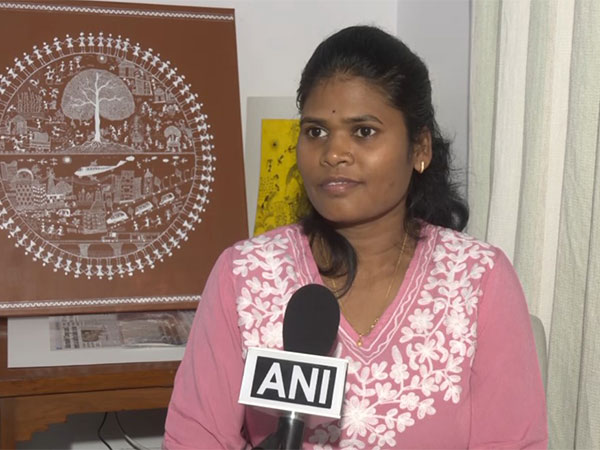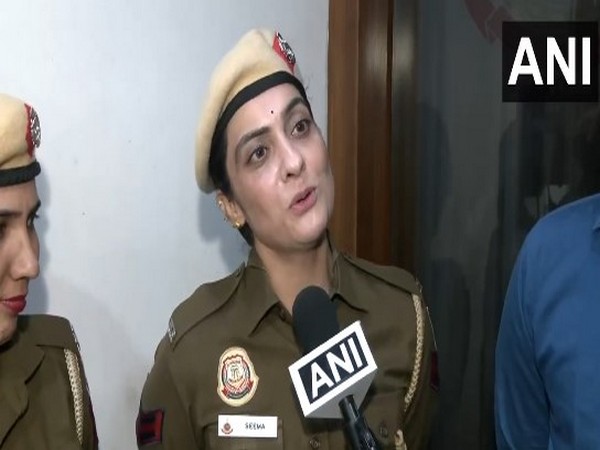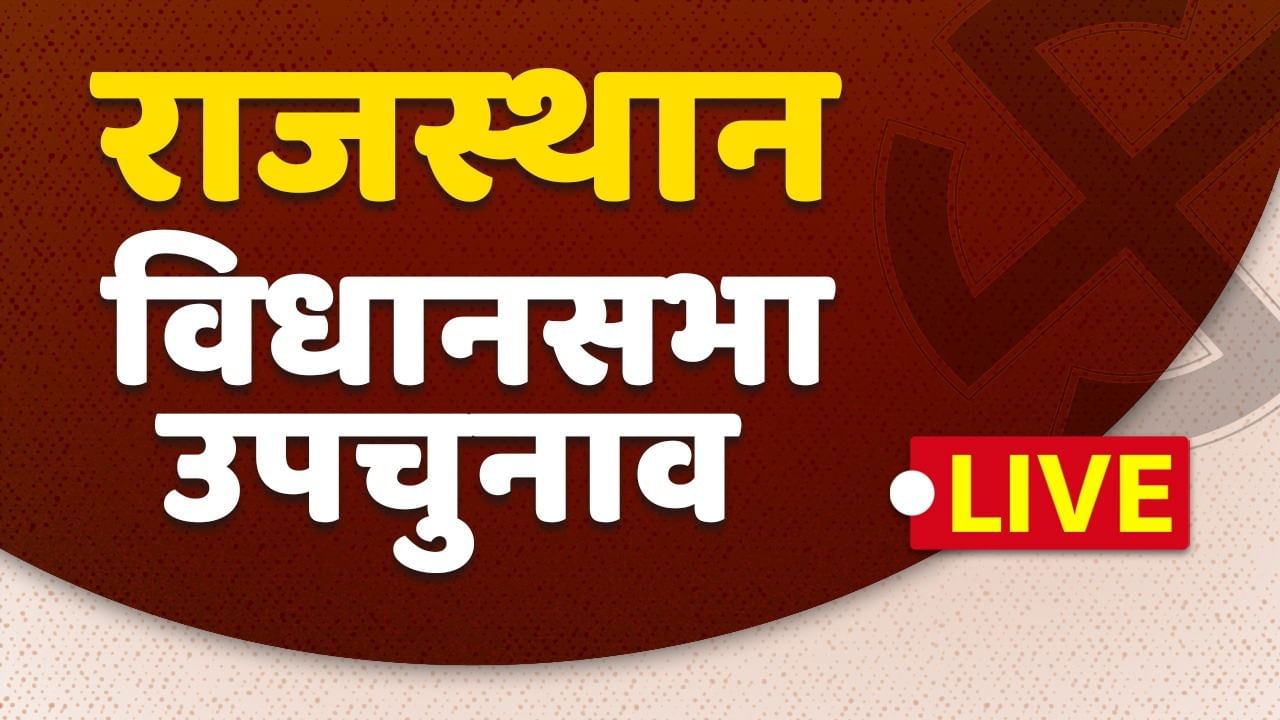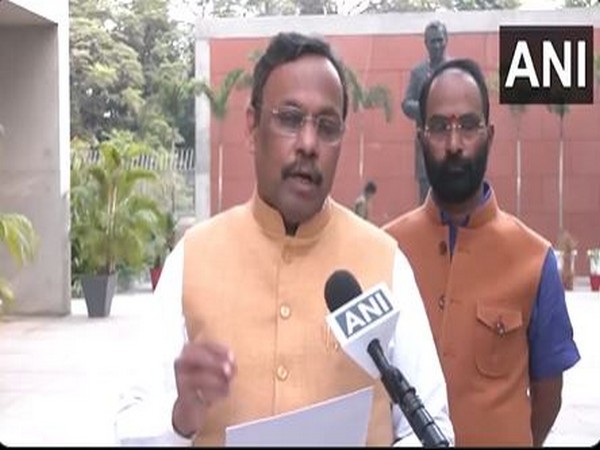Desk |
Updated: Oct 26, 2024 18:49 IST
New Delhi [India], October 26 (Desk): Fifteen artists representing diverse tribal art forms are currently residing at Rashtrapati Bhavan from October 21 to 29, 2024, as part of the prestigious Artists-in-Residence program.
These tribal artists’ work was exhibited at the India Habitat Centre following which President Droupadi Murmu invited them to the Rashtrapati Bhavan for Artist-in-Residence program.
Speaking with Desk, Bharat Lal, Secretary General, National Human Rights Commission said, ‘I am very happy to learn that 15 artists have been selected and they are staying at Rashtrapati Bhawan and attending Artists-in-Residence program. It is a great honor on behalf of the President of India to invite them and participate in this kind of program’.
“The most important part is that government philosophy is that no one is left out. So the tribal communities who live in and around forest area, and they are roughly 8.6% of our population, their cultural rights, their talent, so government is promoting. As you know that in last one decade, they have been the biggest beneficiary of government’s approach of no one is left out. Everybody is getting housing, toilet, clean water, electricity, cooking gas, and in the same spirit, tribal communities are basically being brought from margins to the center. So as they are able to develop entrepreneurship, they are able to showcase their skill, and their talent is recognized,” he added.
“The Artisan Residency Program, is basically another example where effort is that all these tribal people who have certain kind of skill sets, and they have certain conservation ethos, certain value system to protect forest and wildlife and nature. So they are being brought to Rashtrapati Bhavan, where they are going to showcase their skills, and they are going to prepare certain paintings. Idea is that people living in urban areas should know what is India’s conservation ethos,” he further said.
“As you know our Prime Minister has promoted the international solar alliance, the international big cat alliance, the collation of disaster resilience infrastructure, and all these kinds of things. The idea is that this is in our Gandhian principle, that nature has for everyone to meet the requirements, need, but not for greed. And tribal communities are shining examples where they protect forest areas, protect nature, protect water bodies, and extract only what they need,” he added.
So I am very happy that National Human Rights Commission, which also looks after not only civic and political rights, but National Human Rights Commission also promotes cultural, social, and economic rights. So this is a part of that bigger picture where we are promoting the rights of tribal people, and basically trying to bring them dignity, respect, and more opportunities for livelihood, he added.
The plan is that this needs to be showcased not only in Delhi but in different cities of India and maybe abroad. There are many countries in the world, especially in the developed world, that want to know the India’s conservation ethos. They want to learn about what all we have been doing. This country is a 5000 years old civilization, one of the oldest civilizations. And we have this kind of hidden talent, we have this kind of conservation ethos, which the world must know to protect our planet, to handle climate issues, to environmental degradation and more importantly to protect forests, wildlife and nature, various elements of nature, water bodies, rivers. So the plan is that this exhibition and this art forms and these tribals work should be not only taken to different parts of this country but international stage. And we look forward to working on these issues. And I am pretty sure that these tribal communities will be able to showcase their talent and their ethos, their value system at international stage, he said.
A tribal artist named Manoj Gadpal from Kanha Tiger Reserve, Madhya Pradesh said, ‘We have a very good opportunity to work in the Rashtrapati Bhawan. We came here on 15th.The region I belong to is of the Baigajan and Adivasi castes. There are a lot of tribal people there. The villages are very close to the forest. When we came here and started working, we came to the Rashtrapati Bhawan for the first time through the Sankalp Foundation and our exhibition was launched in which artists from all over the country who are doing a good job.
When we were working before, we felt that we were just working for a living. But now the work that we are doing, we feel that we have a better life and a better opportunity for our future generations. Our villagers know that we are working in the Rashtrapati Bhawan through the Sankhala Foundation. It is a matter of great joy. When we return from here, they will welcome us well. The villagers are very happy. I am feeling very good. It is like a dream, Gadpal said.
Diwali has become very good for us because the exhibition which was there from 17th to 20th through Sankhala Foundation, almost 9 of my paintings were sold there. In this exhibition, the most expensive painting was mine. My painting was sold for Rs. 1,25,000. So I don’t have any problem. My Diwali has become very good. I have sent money home. Everyone is happy. So there is no problem, Gadpal told.
Secondly, the exhibition that will be displayed here in front of President, there are very good artists associated with us. I don’t know whose work it is. Everyone is doing it with their hard work. So we will also like it. That’s how it is declared, whose work is appreciated more, he added.
Another artist named Minakshi Khati from Ramnagar, Uttarakhand’s Chohi village described her painting and said, ‘This is Uttarakhand’s Kumaon area’s folk art, Aipan. Aipan means to offer. Uttrakhand is considered as Devbhumi. We start all our activities, festivals, and occasions by remembering our Gods and Goddesses, inviting them, and offering them. I am making this folk art, Aipan, to show them my folk life and culture’.
Expressing her feeling about her time in Rashtrapati Bhawan, Khati said, ‘We are very happy to be here. We have been given the opportunity to come here and work. We are enjoying the atmosphere here. It is like a dream that we have been given the opportunity to work in such a big place. We are getting good vibes here. We are showing the traditional way of our work. It is a very good experience for us’.
“We come from such a small area. In our village, this is a traditional art. My grandmother and mother used to make it for generations. But today, I have come here for the first time. I have got an opportunity from our area. I have come to Rashtrapati Bhawan. I am working here. The people of our village are very happy to see Aipan art is being made at Rashtrapati Bhawan. They are very happy to see that our art has been recognized here. I am feeling very good,” she added.
“A lot of changes have come now. Because earlier it was like folk art. People used to see folk art from a different point of view. It used to be limited to a community. But now it is on such a big platform. We can imagine that our art form will reach the international level very soon. We are seeing a lot of changes. People are looking at it from a different perspective. We are making it on such a big platform. People’s responses have improved a lot, she said.
Another artist named, Krushna Bhusare from Maharashtra’s Palghar district said, ‘It is a very good experience because we never thought that the most important place in India that is the Rashtrapati Bhavan, we will get a chance to work there. We are very happy. My family is also very happy. As you can see, I have made two paintings of Rashtrapati Bhavan here. It is a big thing for me that I am working here. I came here and tried to make the sunset of Rashtrapati Bhavan earlier. I wanted to make a painting here. I got a lot of energy from that. So, it is a very happy thing for me’.
This is a very big opportunity. We live in a tribal village. So, the journey from the village to here is a very big thing for us. It is a very big opportunity for an artist. The path ahead is very good for us. It is a very big thing that we can go ahead and do this kind of work. We would like to come again, he added.
Another artist named, Sumitra Dashrath from Maharashtra’s Melgar Tiger Reserve said, ‘I feel like I am in a dream. I can’t even imagine that I am in Rashtrapati Bhawan. But it has happened that I am in a presidential palace and I am sitting here and painting. I feel very proud. I feel very good that I am getting a chance to sit here and paint. I feel very good that I am getting a chance to sit here and paint. I feel very proud’.
This is a very big thing for me that I have got this opportunity. I want girls from my village to go out. They should study properly. They generally study till 12 and then they stay in the village. Then they get married and then they stay in the village. But I have got this opportunity, so I want to provide this opportunity to other girls. They should also learn from me that we can do something. We can go ahead. We are not less. They will feel this. I am very happy that girls from my village will get to learn from me. Today I have come alone. Next year, if i am called again, I will bring two more girls with me. This is a very good thing for me. It will continue to grow. This painting, this culture can develop, she told. (Desk)





